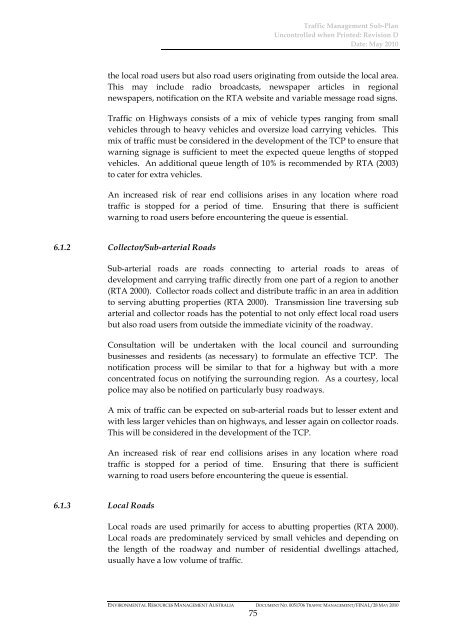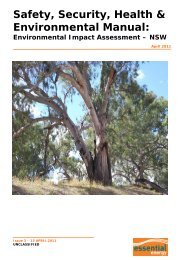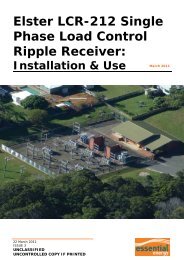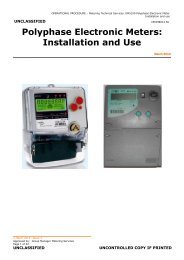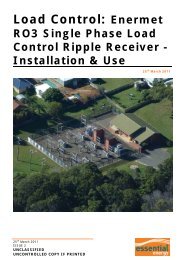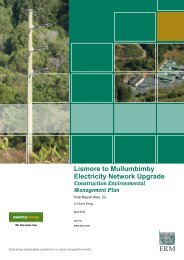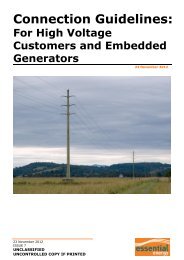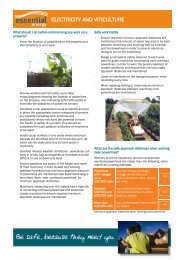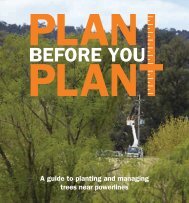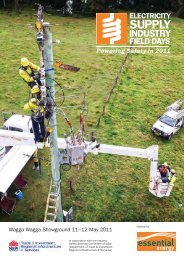Lismore to Mullumbimby Electricity Network ... - Essential Energy
Lismore to Mullumbimby Electricity Network ... - Essential Energy
Lismore to Mullumbimby Electricity Network ... - Essential Energy
Create successful ePaper yourself
Turn your PDF publications into a flip-book with our unique Google optimized e-Paper software.
Traffic Management Sub-Plan<br />
Uncontrolled when Printed: Revision D<br />
Date: May 2010<br />
the local road users but also road users originating from outside the local area.<br />
This may include radio broadcasts, newspaper articles in regional<br />
newspapers, notification on the RTA website and variable message road signs.<br />
Traffic on Highways consists of a mix of vehicle types ranging from small<br />
vehicles through <strong>to</strong> heavy vehicles and oversize load carrying vehicles. This<br />
mix of traffic must be considered in the development of the TCP <strong>to</strong> ensure that<br />
warning signage is sufficient <strong>to</strong> meet the expected queue lengths of s<strong>to</strong>pped<br />
vehicles. An additional queue length of 10% is recommended by RTA (2003)<br />
<strong>to</strong> cater for extra vehicles.<br />
An increased risk of rear end collisions arises in any location where road<br />
traffic is s<strong>to</strong>pped for a period of time. Ensuring that there is sufficient<br />
warning <strong>to</strong> road users before encountering the queue is essential.<br />
6.1.2 Collec<strong>to</strong>r/Sub-arterial Roads<br />
Sub-arterial roads are roads connecting <strong>to</strong> arterial roads <strong>to</strong> areas of<br />
development and carrying traffic directly from one part of a region <strong>to</strong> another<br />
(RTA 2000). Collec<strong>to</strong>r roads collect and distribute traffic in an area in addition<br />
<strong>to</strong> serving abutting properties (RTA 2000). Transmission line traversing sub<br />
arterial and collec<strong>to</strong>r roads has the potential <strong>to</strong> not only effect local road users<br />
but also road users from outside the immediate vicinity of the roadway.<br />
Consultation will be undertaken with the local council and surrounding<br />
businesses and residents (as necessary) <strong>to</strong> formulate an effective TCP. The<br />
notification process will be similar <strong>to</strong> that for a highway but with a more<br />
concentrated focus on notifying the surrounding region. As a courtesy, local<br />
police may also be notified on particularly busy roadways.<br />
A mix of traffic can be expected on sub-arterial roads but <strong>to</strong> lesser extent and<br />
with less larger vehicles than on highways, and lesser again on collec<strong>to</strong>r roads.<br />
This will be considered in the development of the TCP.<br />
An increased risk of rear end collisions arises in any location where road<br />
traffic is s<strong>to</strong>pped for a period of time. Ensuring that there is sufficient<br />
warning <strong>to</strong> road users before encountering the queue is essential.<br />
6.1.3 Local Roads<br />
Local roads are used primarily for access <strong>to</strong> abutting properties (RTA 2000).<br />
Local roads are predominately serviced by small vehicles and depending on<br />
the length of the roadway and number of residential dwellings attached,<br />
usually have a low volume of traffic.<br />
ENVIRONMENTAL RESOURCES MANAGEMENT AUSTRALIA DOCUMENT NO. 0051706 TRAFFIC MANAGEMENT/FINAL/28 MAY 2010<br />
75


